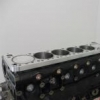Announcements
-
Similar Content
-
Latest Posts
-
Well.... yes and perhaps no. It depends on what you mean by "spool". For most of us, the point that we would describe as where the turbo is "spooling" is the point where the wheel speed gets high enough for it to start making some boost. This is coincidentally around about the point where it starts making noise - hence the "spooling" sound. If that is what you mean, then no - the wastegate should still be shut at this point. The boost will still be way below the point where it should start opening. If, on the other hand, you mean "spool" as "reach full boost", then yes. At the point where the boost has reached target, then boost control has already started. The wastegate is already open, and has been for some time. Some short time, definitely, but still, some time. If you have no boost controller - just the wastegate actuator connected to the boost source, then you have a mechanical system working as a pressure balance. There is pressure on one side of the wastegate actuator's diaphragm from the spring, and pressure on the other side coming from the boost measurement location (the "source"). This is not a digital thing. The wastegate does not stay shut until the boost pressure reaches the spring "pressure". The spring will start to compress as soon as you start to apply any pressure onto it. This can be controlled somewhat by adding pre-load into the spring, but you cannot add enough preload to make it into a digital switch behaviour. The wastegate will crack open and start to leak exhaust out (and therefore not though the turbine) well before you reach the target boost pressure. Electronic (and some mechanical/pneumatic) boost controllers will act to prevent the boost source applying pressure to the actuator until just before you reach target boost, thus preventing the wastegate from creeping open. And some boost controllers will apply boost pressure on the spring side to further push it shut. And this can be be necessary because the exhaust pressure in the manifold also pushes on the wastegate valve and tries to open it and you cab get it leaking even without it being connected to the boost source.
-
By Dose Pipe Sutututu · Posted
A stand alone boost controller will not give you the control you need, unlike a modern ECU. Your boost will always naturally target the wastegate's opening pressure first, your controller then will allow you to add more boost as required. -
I recently discovered that I could not remove the outer bolt on one of my rear UCAs. Looked like it was seized to the crush tube. It wasn't all that long since I had last had that arm out (I dunno exactly, but certainly <2 yrs), so I was a bit surprised. I thought I had stock bushes in the rear knuckles, so I ordered some new PU bushes and resigned myself to having to do some dismantlery....and some butchery. It was clear that the seized bush was going to need to have the bolt cut out of it and then possibly some more brutality after that. Upon getting the 3x arms on each side disconnected from the knuckles (with the exception of the seized one, of course), I discovered that I had in fact put PU bushes into the knuckles when I did the subframe conversion about 12-13 years ago. So, I say "Oh, good, I might not have to swap any of these others out". We set to work butchering the bolt out of the seized arm. Stainless blade in a big-arse Milwaukee recipro made short work of it, and also damaged the arm, which added a welding and grinding and painting step to the whole exercise. During the butchery it became clear that the bolt was not just seized but bent. Head scratching ensued, as it is hard to understand how that bolt could get bent. I did suffer a broken (stock) toe control arm on that side a few months ago, and drove some miles with some significant rear wheel self steer and lack of control, which probably was the cause. But it's still hard to understand how it would bend that bolt, rather than just bend the arm. But here's the start of the real discoveries. The crush tube was rusty as all shit. I mean seriously rusty. A little on the inside, contributing to the tube seizing to the bolt (along with the bend). But the outside had at least 2-3mm of compressed flaky iron oxide jammed in between the parent metal and the PU bush. This one was brutalised and still took some effort to get the PU off the crush tube. So I thought I'd inspect the others more closely. The one on the tension rod adjacent the bent one was first. I had to use a 2-jaw puller to get the crush tube out, and it took some effort. It came out looking like the first one. All 6 of them were the same, except for one that looked not too bad. Had some corrosion on it, but was mostly OK. There was also a significant amount of corrosion on the inner surfaces of the knuckles. They took some convincing with pointy tools to let go their grip on the inside of the holes they were in. There was no sign of the original (SuperPro) lube anywhere. I and my bro-in-law have never seen any crush tube end up looking like this. It was seriously like the car has spent time putting boats into the water at the boat ramp. So, it seems like the PU might have been bonded to the steel on both sides, which would have to make them work more like stock rubber bushes (where arm deflection results in twist inside the rubber). Despite this, I have never had cause to believe that they were so tightly bound up. The suspension moved up and down much as you'd expect. The car never made any noises in those bushes that would have led me to believe there was a problem. Maybe the rusty interfaces actually were "sliding". Anyway, lesson learnt. Even quiet, non-troublesome PU bushes should be inspected every now and then!
-
the boost controller allows you to adjust the opening of the wastegate (which only has one preset spring) I'm going to see how it acts on it
-
I studied the principle of wastegate to begin with. so if I understood correctly. the moment when the turbo "spool" is where the boost control begins. When the target level of "psi" is reached the wastegate opens to regulate the exhaust pressure passing through the turbo and thus control its speed and the rate of boost
-






Recommended Posts
Create an account or sign in to comment
You need to be a member in order to leave a comment
Create an account
Sign up for a new account in our community. It's easy!
Register a new accountSign in
Already have an account? Sign in here.
Sign In Now